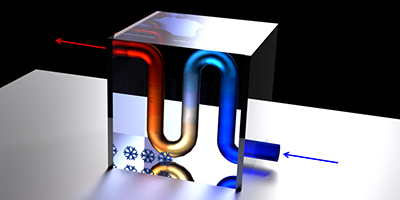May 18, 2015 report
New way to cool micro-electronic devices

(Phys.org)—A team of researchers working at the University of Grenoble has developed a new way to cool solids at the micro level. In their paper published in Physical Review Letters, the team describes how they used laser light to remove vibrational heat from a semiconductor material.
Scientists have known for some time that it is possible to cool a solid by shooting it with a laser beam, a technique known as anti-Stokes fluorescence (ASF)—the laser beam creates an electron-hole pair, aka an exciton, which in turn absorbs thermal energy, aka phonons. When the exciton decays, it forms into a photon, which escapes as light. One problem with this approach has been a tendency for some excitons to decay in a way that allows the heat to return to the material. In this new effort, the researchers found a way around this problem.
The new approach involves the use of polaritons instead of excitons—polaritons are formed when photons interact with excitons. To make use of polaritons, the researchers had to force them to be confined in a semiconducting sandwich cavity (partially transparent mirrors keep them from escaping) preventing them from decaying via just phonons. The result is a method for using a light beam to cool very tiny solid materials, such as those perhaps, that are used in electronic devices.
The researchers note that in addition to being an improvement over conventional ASF schemes, their technique should work the same way at extremely low temperatures, (because the polaritons interact with phonons and polaritons allowing for absorption of phonons over a large range of energies.)
The team acknowledges that their technique has a long way to go before it could be used to create actual device coolers, but insist that in the end it should work, and further suggest when that occurs, the polaritons could offer their cooling in two different ways, fast, or slow. The fast approach would allow for quicker cooling, but would result in more heat being returned to the material. The slow approach on the other hand would take longer but would be more efficient. The team plans to next build a "polariton refrigerator" that should be able to actually cool very small objects.
More information: Exciton-Polariton Gas as a Nonequilibrium Coolant, Phys. Rev. Lett. 114, 186403 – Published 5 May 2015. dx.doi.org/10.1103/PhysRevLett.114.186403 . On Arxiv: arxiv.org/abs/1412.2630
ABSTRACT
Using angle-resolved Raman spectroscopy, we show that a resonantly excited ground-state exciton-polariton fluid behaves like a nonequilibrium coolant for its host solid-state semiconductor microcavity. With this optical technique, we obtain a detailed measurement of the thermal fluxes generated by the pumped polaritons. We thus find a maximum cooling power for a cryostat temperature of 50 K and below where optical cooling is usually suppressed, and we identify the participation of an ultrafast cooling mechanism. We also show that the nonequilibrium character of polaritons constitutes an unexpected resource: each scattering event can remove more heat from the solid than would be normally allowed using a thermal fluid with normal internal equilibration.
Journal information: Physical Review Letters
© 2015 Phys.org



















